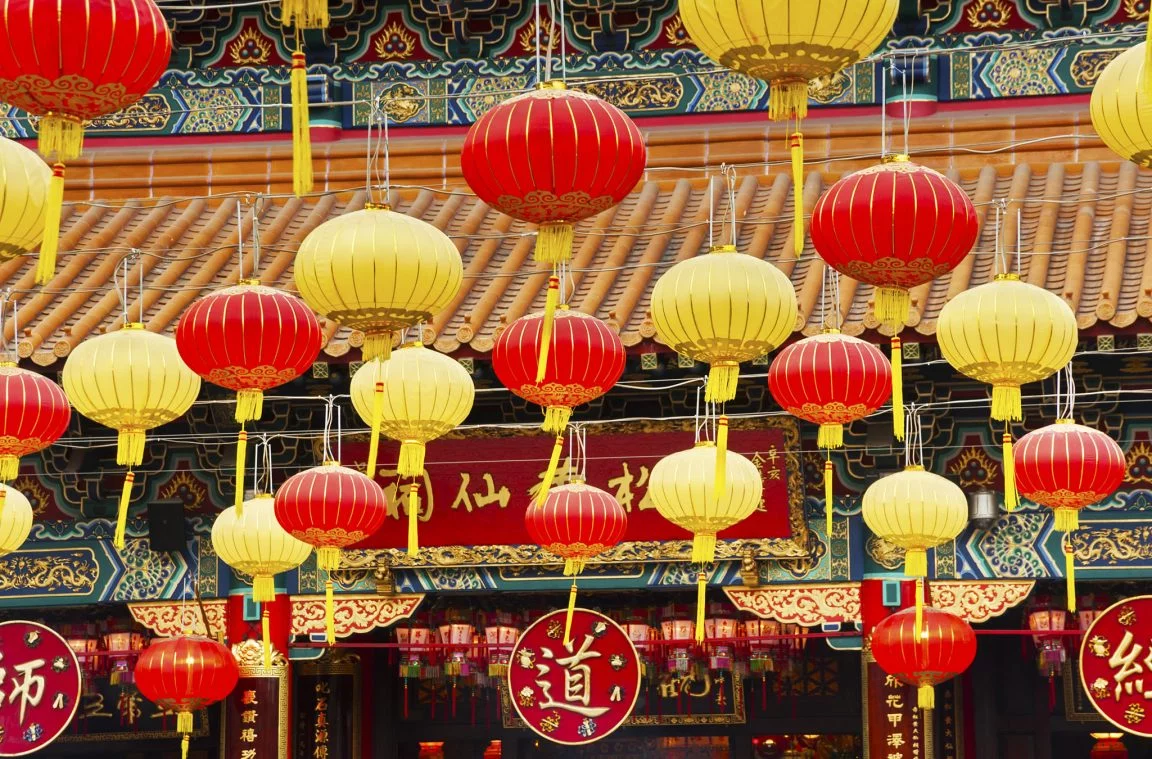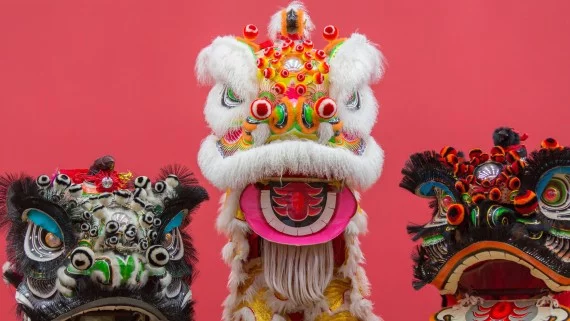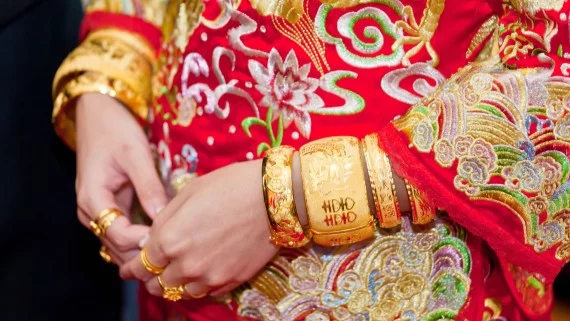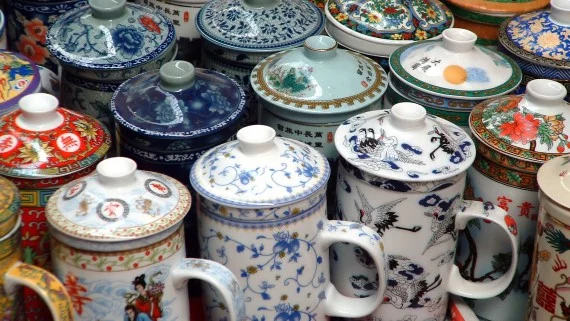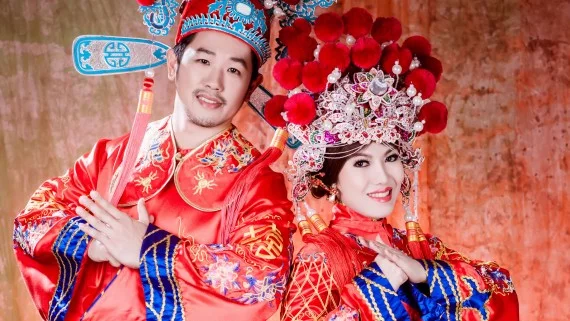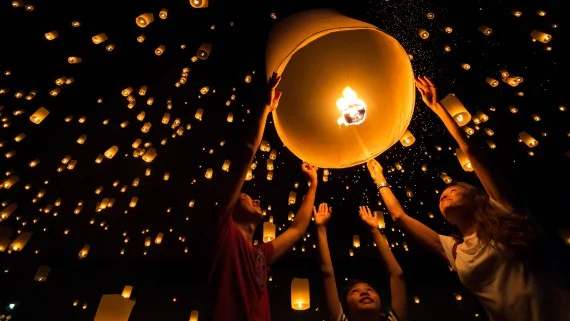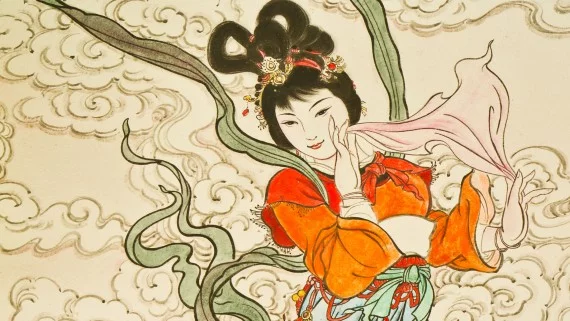The set of traditions of China includes one of the most ancient and complex cultures in the world. Highly influenced by the Buddhist religion, Taoism and Confucianism, its greatest exponents are mythology, art, philosophy and music. In this article you will learn what are the most important Chinese traditions today.
Below you have an index with all the points that we are going to deal with in this article.
Article Index
- 1.
- 2.
- 3.
- 4.
- 5.
- 6.
- 7.
- 8.
- 9.
- 10.
- 11.
- 12.
- 13.
- 14.
- 15.
- 16.
- 17.
- 18.
- 19.
- 20.
- 21.
- 22.
- 23.
Chinese New Year
The Chinese New Year, better known as the Spring Festival or lunar New Year, is the most important festival of the year within the Chinese calendar, although it is also celebrated in other countries in East Asia. This celebration is based on the lunisolar calendar used in China. Thus, the celebrations begin on the first day of the lunar month and end after fifteen days, coinciding with the Lantern Festival.
The start date of the Chinese New Year depends on the position of the Moon. Thus, the new year begins on the day closest to the winter solstice (December 21-23) and the day equidistant from the spring equinox (March 20-21). Taking these dates into account, the resulting day always falls on a date that is between 45 days after the winter solstice and 45 days before the spring equinox.
Also, during Chinese New Year celebrations it is frowned upon to speak of the past or to punish children, since if a child cries during the New Year, he will cry all year long according to popular belief. It is also customary to open all the doors and windows of the houses from 0:00 to let out the previous year, with all the bad that may have happened in it. In this way, they ensure that the new year enters "clean" in each house.
At lunchtime
The famous chopsticks They bring with them several very interesting legends. One of the most popular is the one called Dayu Zhishui yu Kuaizi, dating back to the era of Kings Yao and Shun.
By order of King Shun, the soldier Da Yu had the mission to channel the waters of the river that were causing serious floods in the population. The soldier swore that he would solve this problem and, therefore, did not stop for a single minute to get it. However, one day he came to a small island hungry and decided to cook meat in a pot. When he finished, he realized that he had no silverware, so he took two twigs from a tree and began to eat. And this is what he has done since then.
In addition, chopsticks harbor a series of superstitions around them. For example, sticking them into rice is frowned upon, as it is largely reminiscent of the act of placing incense at funerals. It is also rude to hit the plate with them, since it is what beggars do to beg. If you want to learn to eat with chopsticks, you can do it with this interesting video:
On the other hand, the structure of the classic Chinese menu is made up of about three or four cold hors d'oeuvres that must be on the table before the diners arrive. Once everyone is seated at the table, the main dishes will be served, including rice and four other trays of hot dishes. Soup is also usually served as an accompaniment. It is also very important wipe your hands with a warm cloth before you start eating.
It is considered rude to overfill the plates, stir the rice into the bowl, return a tray to the table without having taken anything from it, and choose the pieces of food. All these gestures, among others, are frowned upon because they imply that we have not liked the food. Remember that you should not leave the chopsticks in the plate or drink until the host has done so.
The direction when sweeping
The Chinese live immersed in a culture full of history, knowledge and wisdom, so it is not surprising that they have a good handful of superstitions and somewhat strange customs. One of them is the one that has to do with the direction in which you sweep.
According to this belief, you should always sweep from the outside in and, in addition, all the dirt must be collected in the same collector before emptying it. This custom makes the most superstitious Chinese extremely careful when sweeping.
This tradition is due to Buddhism, since, according to the god Buddha, the broom is one of the objects that attract the good luck (apart from elephants, red hearts and corals, among others). In addition, the ideal would be for the bristles of the broom to be made of natural fiber and not plastic, and a green ribbon should be tied in the center of the stick.
The position of the rings
The way the Chinese wear the rings on the fingers of the hand is governed by an ancient legend according to which each finger represents a different aspect of life.
Thus, the ring finger or fourth finger represents the couple and that is why the engagement ring should be placed on this finger, both in men and women. On the other hand, the thumbs represent parents, while the index fingers correspond to siblings and close friends.
The middle finger represents the I, that is, oneself and the little finger is the representation of the children or, if there are none, it is a way of ensuring that there will be offspring.
Chinese ceramics
Among the art forms of Chinese culture, ceramics is one of the most prominent. Chinese pottery has been in production for thousands of years, specifically since the era of the dynastic periods, approximately 20.000 years ago, during the Paleolithic.
The Chinese are the inventors of the porcelain And, for this reason, they have a long tradition in terms of techniques, enamels and innovations.
The earliest Chinese potters date back to the Yangshao culture (c. 4000 BC). Later, already in the Longshan culture, the lathe began to be used to fine-tune and reach the height of certain pieces, as shown by several examples preserved today.
The most famous productions around the world are the blue and white vases, dating from the time of the Mongol Yuan Dynasty. At present, Chinese master potters continually seek to innovate in order to achieve more and more refined pieces.
Red string of destiny
The red thread of fate is a widely held belief not only in China, but throughout East Asia, as it comes from Chinese and Japanese mythology. According to legend, it exists in a affective bond or "red thread of destiny" that comes with people who are destined to love each other from birth.
This thread exists even before these people meet and is unbreakable, although it can be more or less tense, depending on how strong the bond between these people is. Literally, the text of the caption reads as follows: “An invisible red thread connects those who are destined to meet, regardless of time, place or circumstances. The thread can be stretched or contracted, but never break.
This is why there are several expressions in Japanese or Chinese in which the red thread is referred to, such as in we're building bridges with red threads o we are pulling hard on the red thread.
When getting married
In ancient China, men could have as many concubines as they wanted after getting married for the first time. However, this custom changed thanks to a law that was imposed from the 50s, according to which a man could only marry one woman.
Although this tradition has changed today, some customs from ancient China have been preserved to this day. Today you can freely choose who will be your husband or wife, show respect for each other's parents it remains a core value.
Before getting married, for example, they must formally visit each other's parents. When the man visits his future in-laws, he should take with him a series of wedding gifts as a way to show your sincere intentions and as a symbol of the love you feel towards your partner.
Furthermore, once engaged, the bride and groom must carefully choose their wedding date. Like choosing the baby's name, the wedding date should be based on the Chinese lunar calendar to attract good luck.
As for the wedding itself, the color red is the predominant color, since it is a symbol of love, fidelity and prosperity. The wedding day (called hunqi), the woman will have her face completely covered by a veil of color, once again red.
Foot bandage
The custom of foot binding from birth to Chinese girls is no longer practiced today. However, it was a deeply ingrained custom until its decline began in the XNUMXth century. This tradition originated in the era of the Song Dynasty (XNUMXth century) among the dancers of the upper class, who must have «lotus feet«; women of the lower classes did not practice it because it prevented them from performing well in their work.
Foot wrapping became popular over time, as it was very attractive to men. To get some "lotus feet", women had to wear lotus shoes, that is, cone-shaped shoes representing a lotus flower bud. They were constructed of cotton or silk and were so small that they could fit in the palm of the hand.
Today, there are families in the city of Canton who pride themselves on having ancestors with “lotus feet”. But this tradition ceased to be practiced as a result of the numerous campaigns against foot binding that began in the XNUMXth century, since it was considered a barbaric and archaic practice that caused motor disabilities for life in women.
The meaning of colors
Colors are key elements in Chinese culture, inherited from the belief that surrounded them in Ancient China. Thus, colors were considered to symbolize people's social position. Today, however, this use has become obsolete and the colors only have a specific meaning.
El yellow, for example, it was the color of the nobility and the privileged classes. In short, it was the color of emperors and empresses, princes and princesses, and they had the exclusive right to wear clothes of that color. But why the yellow color? Because it was the color of the earth, as agriculture plays an extremely important role in the Chinese economy.
The black and the whiteInstead, they represent negative values such as death and bad luck. This is why the color of the wedding dress in Chinese weddings is not white, and the objects, invitation cards and other elements related to the wedding are not white, but red.
Color Red it is the color of hope, good luck, animation, progress, beauty… In short, it represents all that is good and, therefore, it is the color that the bride and groom wear at the wedding. Also the Chinese flag is red as a way to represent these values.
When celebrating birthdays
Chinese traditions and customs related to birthday celebrations are among the most curious from the first year of life. For the Chinese, turning one year of life is a momentous event and, therefore, must be celebrated according to the so-called Zhuazhou tradition.
This ceremony consists of the parents of the baby placing a series of items in front of their little one and letting them freely choose the one they like the most or attract attention. This choice, although a priori it seems made at random, in reality will be decisive to know what their inclinations and capacities will be during adulthood.
The Zhuazhou tradition has been celebrated since the Song Dynasty era (960-1279 AD). It is a merely family party, not an occasion for large parties or elaborate gifts. Gifts brought by family members should not be luxurious (eg gold or silver), but should be limited to toys or dim sum, One typical dishes of China.
Another custom to take into account if we interact with a native Chinese person is the one that has to do with give and receive gifts. First, gifts must be given and received with two hands, never just one.
In addition, it is not well seen to open the gift if the one who gave it to us is still in front of us: we must wait until it is gone. On the contrary, it is considered polite to hold back, although we can also wait for the other person to insist that we open it or even ask if we can.
Returning to the issue of colors, you should avoid wrapping gifts in white or black paper wrappers, since, as we have said before, these are the representative colors of the negative (death or bad luck).
Finally, another of the quintessential Chinese traditions for birthday is to take the famous longevity noodles o sau mein accompanied by buns. These are noodles that can measure up to 1 m in length representing a prosperous, long and healthy life. That is why chopping the noodles or biting them is considered an act that will fill our lives with bad luck, since this would mean that we "shorten" our life.
In everyday life, these noodles are called yi mein or noodles e-fu o yify and they are made from egg and wheat flour. Its color is yellow-golden and its texture is hard and spongy to the touch due to the carbonated water with which the dough is made. They are mostly consumed in southern China and Hong Kong, although today they are sold dry in plastic containers.
Meaning of the dragon
It is well known that the dragon is a legendary animal in Chinese folklore. This mythological animal, according to Chinese belief, is made from parts of nine different animals: deer horns, dog nose, lobster eyes, lion's mane, fish scales, catfish whiskers, eagle claws, snake tail and ox's nose.
Furthermore, he is the personification of the concept of that (masculine), whose feminine equivalent is the Chinese phoenix.
The dragon is intrinsically related to water according to various popular beliefs. Thus, it is believed that waterfalls, rivers and seas are under his command. Therefore, there are four Dragon Kings representing the East Sea, the South Sea, the West Sea and the North Sea.
Many cultural references in modern China have to do with dragons. Thus, for example, the number 9 is closely related to this mythological being, since it is described as a being made up of 9 attributes and 117 scales, of which 81 are male (or, what is the same, 9 × 9) . In addition, the dragon is one of the 12 animals that make up the Chinese zodiac.
The famous Duanwu Party or Dragon Boat Festival, as its name suggests, is also related to dragons, since, after all, it is about races on “dragon” boats. These boats, ridden by teams of up to twelve rowers, have a dragon's head carved on the prow. In the following video we can see an example of a dragon boat race held in the city of Shanghai:
One Child Policy
Starting in 1979, a population control measure was introduced in China according to which each couple can have at most one child.
This regulation is known as one child policy and was established in order to radically control the birth rate, given the excessive population growth in China. Currently, China is home to one fifth of the world's total population, making it the most populous country in the world.
This law was introduced in the late 70s in order to reduce the various social and environmental stresses that were happening in China. Unsurprisingly, there are both defenders and detractors of this measure, the latter in response to the “aggressive” way in which it was introduced.
Another important aspect related to birth control in China is the infanticide of girls. This means that in China there is a male child preference on women, since, it is considered, men are the ones who inherit the lineage and will take care of the grandparents in their old age, while the role of women is limited to the care of their family.
Because of this, the Chinese woman, when she becomes pregnant, is usually under strong pressure to give birth to a male child, otherwise she will have to face abuse and humiliation.
Flying lanterns
Flying lanterns, Chinese lanterns, wish balloons, or tissue paper balloons are a kind of aerial lantern made of paper. This custom is very common throughout the Far East, although in recent decades it has been gaining popularity in the West as well.
The materials used for its preparation are rice paper and bamboo, the latter for making the frame, although there are also metal ones. Inside the lantern, a paraffin base is created that is ignited so that the flame heats the air inside the lantern and the air inside the lantern rises towards the sky due to a decrease in density.
Flying lanterns are used in China and in Thailand in equal parts. An example of its use is the famous Moon Festival, as well as the Lantern Festival, both celebrated by both Chinese and Thais. In Thailand, in addition, the lantern can be seen at the Loy Krathong and Yi Peng festivals. In the following video we can see how they celebrate the Lantern Festival in Chiang Mai (Thailand):
The spirit of the tiger
The Tiger has a special value within Chinese culture. The so-called "Spirit of the Tiger" is possessed by those people who have born in february, between three and five in the morning, a period of time in which everything is under his command.
In ancient China, the tiger was known by the name of Hu. Those born in the astrological placement of the tiger, will be people capable of breaking with the classic schemes of society to pursue their ideals and become a legend.
A man born tiger will be daring, powerful y enthusiasticIn addition to being rebellious, charismatic and unpredictable, characteristics that will fascinate everyone. In ancient China, moreover, it was considered that a son born tiger would bring good fortune to the family, especially since it would protect them from fires, ghosts and thieves.
Chinese woman
The treatment that Chinese women have received has evolved over time, as has happened in most developed countries. In ancient times, however, Chinese women ranked low and were often assigned the most despicable and exhausting jobs. Indeed, the society of ancient China was highly male chauvinistAs proverbs like the one quoted below demonstrate: "Listen to your wife, but never believe what she says."
Although Chinese women have been discriminated against on a general level, this machismo has been especially marked in rural areas of the country, where they were considered and made them feel inferior and, in short, submissive. This is why Chinese families traditionally prefer to conceive a boy rather than a girl.
It was not until 1992 that a decisive law came to light to safeguard the fundamental rights of women, that is, the basic rights of every human being. Through this law, the macho mentality also began to be channeled towards a more modern and egalitarian vision of women.
To this day, although there are still some foci where much remains to be done, the XNUMXst century Chinese woman it is far from what could be seen in the previous century. Today women can participate in political, cultural, educational and family sectors, and have support in terms of their rights and freedoms.
Name the children
For the Chinese, welcoming a newborn is a unique experience that will never be repeated. And the way the Chinese do this is related to the name they give to their son or daughter. All this is related to the concept of shenminwenhua, that is, the mystery and the elemental signs.
Chinese parents consider hour and day in which your child was born are decisive when naming him. This is because each time and date correlates with a specific element of nature, be it fire, water, or earth. Therefore, the name must necessarily be associated with the corresponding element. Even when in doubt, many parents turn to a fortune teller to choose a name.
Funeral
There are numerous differences between eastern and western funeral customs. Thus, during the funeral mass, it is tradition to distribute chocolate coins to the attendees as a symbol of continued prosperity and as a way of comforting them at the same time. This custom does not respond to a superstitious belief, but is done as a way of remembering that death is not the end point in people's lives.
To remember the anniversary of the death, relatives do not worship the deceased or feed him or believe that not doing so will attract bad luck. What the Chinese do is leave fruits in front of a photo of the deceased and light candles. To pray for him or her, you must first greet with three bows of the head.
Regarding burial, in China and other Asian countries there is a belief that the higher someone is buried, the better their next life will be and, therefore, they are buried in hanging coffins. Traditionally, many families have a hill of their own on which to bury their ancestors. These coffins, such as those found on Wuyi Mountain, have become quite a tourist attraction.
Clothes and accessories
The typical traditional costume for women used in China is called qipao o cheongsam. From him derives another very popular clothing known as chenongsam, an outfit very similar to the typical Tibetan and Vietnamese dress.
The use of the qipao dates back to the Qing Dynasty (1644), when the Manchu began to use a kind of unisex, straight and one-piece dress, which they gave the name of qipao, Meaning flag dress literally. This is because the Manchu brought the system of administrative division according to flags.
At first, the female qipao was quite baggy and concealed practically the entire body, but from 1990 on it was designed to adapt more to the body, so it became slimmer and more fitted. Since this new design highlighted the female figure, it became the typical outfit of Chinese high society.
Furthermore, the hanfu It is also another of the typical costumes of China. Although it has traditionally been used by the Han ethnic group, the Hanfu ended up becoming one of the typical garments at a general level. He kimono Japanese or the hanbok Korean are heritage of this garment.
In short, hanfu has existed for over 3.000 years and is said to have been the garment of the legendary Yellow Emperor. In its beginnings, the Hanfu consisted of a yi, a narrow-cut tunic that fell to the knee, and a chang or narrow skirt that covers up to the ankles.
Literature
Chinese literature is one of the richest on the planet. Its history dates back to the Ming Dynasty, which used this artistic manifestation as a means by which to entertain the literate masses of China.
Many are the historians who agree in affirming that in the s. In the XNUMXth century, China already had more written texts than any other country in the world thanks to the spread of woodblock printing and the invention of movable type printing by Bi Sheng.
Five are the most important classical Chinese texts: the Book of odes, The classic of history, The book of changes, The classic of rites, The annals of springs and autumns y The classic of music.
On the other hand, Confucian books, such as The great teaching o The doctrine of the just mean They are basic works in Chinese literature. In the field of Chinese prose, the so-called Four Classic Novels, whose titles are mentioned below: Romance of the Three Kingdoms (Luo Guanzhong), At the water's edge (Shi Nai'an and Luo Guanzhong), Journey to the west (Wu Cheng'en) and Dream of the red mansions (Cao Xueqin and Gao E).
Feng Shui
Feng Shui literally means Wind and water and refers to a Chinese philosophical system belonging to Taoism. This ancient set of beliefs is based on the harmonious and conscious occupation of space in order to obtain a positive influence About people.
Based on a knowledge called shenminwenhua, which deals with mysterious and impossible to see things, the territory occupied by Feng Shui is divided into two spheres: on the one hand, the earth or ken kai and, on the other hand, the sky or yu kai, the first being tangible and the second invisible and unknown.
According to Feng Shui, it is the vital breath o who which modifies the shape and arrangement of things in space, as well as the orientation (cardinal points) and temporal changes. This is why there are several schools of Feng Shui where the shape of rivers, mountains and even the arrangement of houses and their relationship with this vital breath are studied.
Many are the Chinese buildings whose architectural design is based on the idea of Yin Yang (Opposites without opposition), since according to this idea, each cardinal point emanates a certain energy. The Bank of Hong Kong or the Bank of Shanghai are examples of buildings built on the principles of the feng shui.
Traditional music
The musical tradition of China dates back to the times of the Zhou Dynasty (1122 BC-256 BC), that is, the beginnings of Chinese civilization. Music was so important to the Chinese in the past that today it continues to be a source of culture, especially in mainland China, where several of the most ancient customs in the field of the arts are kept alive.
Focusing on traditional Chinese music, this is played with woodwind instruments and percussion, such as the dizi, the paigu, the gong, the paixiao, the cymbals, etc.
Also typical are some instruments with rubbed strings such as the dahu, gaohu or yehu, and others with plucked strings such as the zhù, yangqin or konghou. On the other hand, Chinese bamboo flutes are also typical, which, along with guqin, are the oldest Chinese instruments. As for vocal music, there is usually more emphasis on melody than on harmony and is usually sung in falsetto. In the following video we can see an example of what a traditional Chinese ballad would be:
Practice taichi
El tai chi or tai chi chuan, adapted to Spanish as Tai Chi (all together and without accent), is a type of martial art developed in China that is currently practiced throughout the world. In the People's Republic of China, tai chi it is practiced very frequently, so it is not strange to find people practicing it in parks.
Tai chi movements are basically slow and fluid, aimed at improving the quality of life both emotionally and physically. It is definitive, it is a physical-spiritual practice in which physical exercise is combined with the technique of meditation. It is important to mention in relation to this, that in the field of Tai Chi Chuan there is no grading system as in other combat sports (eg karate or kung fu).
Take you
Tea is the favorite drink of the Chinese, mainly for its beneficial properties. In China, there is a whole tea drinking culture It does not only respond to a habit, but goes further: it is a way of maintaining health.
It is not strange when walking through the streets of the country to come across Chinese people with a thermos of hot tea in hand, especially adults and the elderly. You can even ask for hot water in any establishment to fill the thermos and they will provide it to us for free.
In addition, China has a wide variety of teas, among which stands out, above the rest, the green tea, which is obtained from the natural drying of the leaves of the tea tree. For the Chinese, green tea is much healthier than black tea, in addition to helping to lower cholesterol, lose weight and prevent various diseases.
China is the second largest tea producer in the world after India, where drinking tea is another of the indian customs par excellence.
This article has been shared 220 times. We have spent many hours collecting this information. If you liked it, share it, please:
